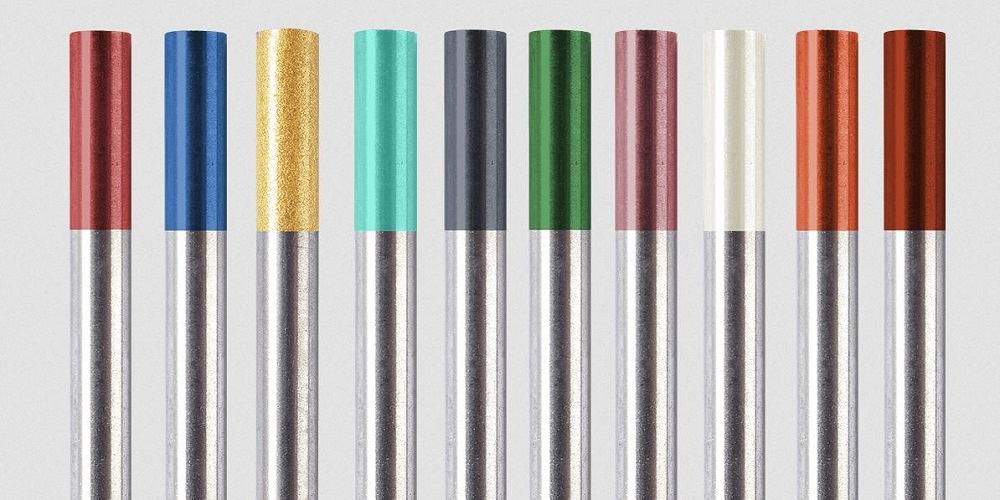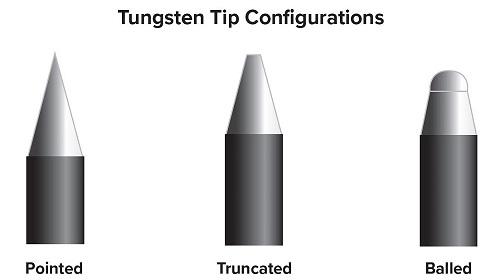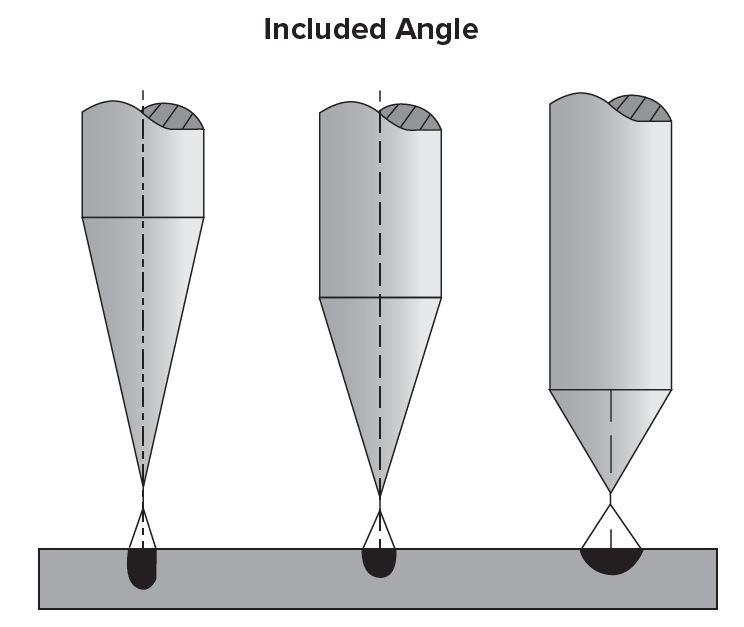Marketing Consultant
- FMA
- The Fabricator
- FABTECH
- Canadian Metalworking
Categories
- Additive Manufacturing
- Aluminum Welding
- Arc Welding
- Assembly and Joining
- Automation and Robotics
- Bending and Forming
- Consumables
- Cutting and Weld Prep
- Electric Vehicles
- En Español
- Finishing
- Hydroforming
- Laser Cutting
- Laser Welding
- Machining
- Manufacturing Software
- Materials Handling
- Metals/Materials
- Oxyfuel Cutting
- Plasma Cutting
- Power Tools
- Punching and Other Holemaking
- Roll Forming
- Safety
- Sawing
- Shearing
- Shop Management
- Testing and Measuring
- Tube and Pipe Fabrication
- Tube and Pipe Production
- Waterjet Cutting
Industry Directory
Webcasts
Podcasts
FAB 40
Advertise
Subscribe
Account Login
Search
Tungsten electrode selection and preparation for welders
Overlooked, underappreciated—yet very important for the highest quality and repeatability of welds
- By Jon Bowers
- November 14, 2023
- Article
- Consumables

Welders, take note: Choosing the optimal tungsten electrode requires you to consider the right tungsten material, tip geometry, and tip preparation.
Welders recognize the significance of having the right tools, from the power source down to the torch and every piece that connects them. Yet, surprisingly, the most overlooked element is also arguably the most vital to the entire welding process: the tungsten electrode. It serves as the final connection that brings the weld to life. Its durability and ability to withstand heat make it an ideal conduit for delivering the welding current to the arc. However, it is puzzling how this crucial component often goes unnoticed and unappreciated. To choose the optimal tungsten electrode, you must consider the tungsten’s material, tip geometry, and tip preparation. Only by focusing on these intricate details can you ensure the highest quality and repeatability of welds.
Tungsten Material
Electrodes are made from either pure tungsten or a mixture of tungsten and other rare-earth elements and oxides. Each electrode is assigned a specific color code, which is prominently displayed on its tip. The following is a description of the common tungsten types and their uses.
Pure Tungsten - AWS Classification: EWP; Color Code: Green. Pure tungsten, which is at least 99.5% tungsten, offers stable performance when paired with AC welding, whether it is a balanced wave or continuously high-frequency stabilized. This tungsten retains a neat balled end, ideal for welding aluminum and magnesium.
2% Thoriated Tungsten - AWS Classification: EWTh-2; Color Code: Red. These electrodes comprise a minimum of 97.3% tungsten with 1.7% to 2.2% thorium. These are among the most popular electrodes in use today, renowned for durability and user-friendliness. However, due to its radioactive nature, many welders look for other alternatives. These electrodes are primarily employed for specialized AC welding tasks, like thin-gauge aluminum or materials thinner than 0.06 in., and DC welding. It is suitable for carbon steel, stainless steel, nickel, and titanium, either with electrode negative or straight polarity.
2% Ceriated Tungsten - AWS Classification: EWCe-2; Color Code: Gray. This electrode contains a minimum of 97.3% tungsten and 1.8% to 2.2% cerium. They perform best in DC welding at low current settings. EWCe-2 has excellent arc starts at low amperages, making it essential for orbital tube and pipe fabrication, sheet metal, and applications with small parts. Ceriated electrodes offer similar versatility to thoriated electrodes and often replaces them in low-amperage applications.
2% Lanthanated Tungsten - AWS Classification: EWLa-2; Color Code: Blue. This electrode boasts a wide range of applications and amalgamates some of the finest characteristics observed in other tungsten variants. It is celebrated for its superior arc initiation at minimal amperages, its low wear rate, and its reliable reignition capabilities. Within the industry, lanthanated tungsten is recognized as a versatile substitute for thoriated and ceriated electrodes because it encompasses the best qualities of both.
Zirconiated Tungsten - AWS Classification: EWZr-1; Color Code: Brown. This electrode has 99.1% tungsten with zirconium content ranging between 0.15% and 0.40%. Its balled tip and strong resistance against contamination make it perfectly suited for AC welding. While its current-carrying capacity matches or even surpasses that of thoriated tungsten, the zirconiated electrode is not recommended for DC welding applications.
Tri-Mix Tungsten - AWS Classification: EWG; Color Code: Turquoise. Unlike the radioactive 2% thoriated tungsten, Tri-Mix is a nonradioactive substitute. Infused with a scientifically harmonized blend of three rare-earth oxides, it optimizes migration and evaporation rates, thereby prolonging the life of the tungsten. This tungsten variant delivers a stability and uniformity that is unparalleled by many other tungsten types.
Tungsten Geometry and Preparation
Electrode geometry and preparation play a significant role in determining electrode longevity, arc initiation, arc shape, and welding penetration depth (see Figure 1). Given these factors, it is evident that the geometry of your tungsten electrode is a pivotal aspect of the welding procedure, demanding precise adherence to tight tolerances for every weld.
Electrode Diameter. When selecting an electrode diameter for your needs, you're essentially trying to strike a balance between ease of arc starting and the longevity of the tungsten—two factors that often oppose each other. Although starting with the manufacturer's guidelines is a wise move, it is also beneficial to do your own testing to determine the best fit for your specific tasks.

FIGURE 1. The geometry of your tungsten electrode is a pivotal aspect of the welding procedure, demanding precise adherence to tight tolerances for every weld.
Tungsten with a smaller diameter provides:
- An easier arc initiation.
- Faster wear and tear.
- A higher chance of weld contamination.
On the other hand, tungsten with a larger diameter offers:
- A higher capacity for amperage.
- Extended tungsten lifespan.
- Challenges in arc initiation.
- Less stable arcs.
Tungsten Tip. Choosing the right end configuration—balled, pointed, or truncated—is crucial in optimizing results and preventing potential contaminants and additional corrections (see Figure 2).
AC welding electrodes—most commonly pure or zirconiated—necessitate a balled tip. This tip is apt for sine wave and standard square wave GTAW power sources. The diameter of the balled tip shouldn't be more than 1.5 times the electrode's diameter since it can compromise arc stability and may detach, leading to weld contamination.
To achieve a balled tip, no intricate preparation is required. Simply apply an AC current and the ball will naturally form at the electrode's end.
For DC or inverter AC welding—thoriated, ceriated, lanthanated, and Tri-Mix electrodes—a pointed and/or truncated tip is necessary.
Larger flat surfaces can make arc initiation harder and may cause arc wandering. But by optimizing the flat size, you can ensure a stable arc and also extend the electrode's lifespan, especially for high-amperage uses.
A pointed tungsten tip is recommended for welding on thinner materials, between 0.005 and 0.040 in., using a low current. This shape provides a focused arc transfer, which reduces the possibility of warping in sensitive metals like aluminum. However, a pointed tungsten tip isn't suitable for high-current jobs. The strong current can wear down the tip and contaminate the weld puddle.
On the other hand, a truncated tungsten tip is more suitable for tasks requiring high current. To craft this, you'd first shape the tungsten into a taper, then fashion a 0.01- to 0.03-in. flat surface at the end. This design lessens the chances of tungsten contamination in the arc and prevents a ball from forming at the tip.
Included Angle. For DC welding, electrodes should be ground in a longitudinal and concentric manner using a high-quality diamond grinding wheel (see Figure 3). The specific angle at which it is ground influences the arc's shape, the simplicity of arc initiation, the longevity of the tungsten, and the depth of weld penetration.

FIGURE 2. It is crucial to choose the correct end configuration to optimize results and prevent potential contaminants and additional corrections.
A blunt taper with a wider included angle provides:
- A longer electrode lifespan.
- An enhanced weld penetration depth.
- A narrower weld bead.
- Increased amperage-handling capability.
Conversely, a sharp taper with a smaller included angle ensures:
- Effortless arc initiation.
- Superior arc stability.
- Broad weld bead contour.
Tungsten Preparation. Properly preparing tungsten electrodes for welding is a meticulous task, and the era of resorting to general shop belt sanders or multipurpose grinders is a thing of the past. It is now imperative to employ a dedicated diamond grinding wheel specifically for tungsten preparation.
Although tungsten is notably hard, a high-quality diamond wheel is even tougher, ensuring a grind that's smooth and devoid of rough edges or any unseen surface flaws that might lead to welding inconsistencies or outright failures.
Reserve the diamond grinding wheel exclusively for tungsten to prevent contaminating the wheel and the electrode tip and potentially introducing foreign materials into the weld.
The most crucial aspect of correctly grinding a tungsten electrode is ensuring it is done longitudinally (see Figure 4). A tungsten electrode's grain structure runs lengthwise; grinding crosswise means you're grinding against this structure. Electrons densely populate the electrode's surface. If ground or polished across, electrons jump over these grinding marks and cause the arc to initiate prematurely, disperse, and often deviate. Longitudinal grinding results in a stable and focused arc.
A diamond cutting wheel ensures the cut remains clean, smooth, and free from splinters or fractures. The tool used should be user-friendly, equipped with safety shields, and incorporate a scale for precise measurements.
Other preparation methods are ill-advised. These include:
- Breaking the electrode by hand.
- Using wire cutters.
- Twisting it with pliers.
- Notching it on the grinding wheel and then snapping it.
- Striking it with a hammer against a sharp metal edge.
These methods can compromise weld quality, and there's also the risk of the electrode fragmenting in ways you can't easily detect, leading to an unstable arc and welding flaws. Such methods can jeopardize your safety, risking hand or eye injuries.
About the Author
About the Publication
Related Companies
subscribe now

The Welder, formerly known as Practical Welding Today, is a showcase of the real people who make the products we use and work with every day. This magazine has served the welding community in North America well for more than 20 years.
start your free subscription- Stay connected from anywhere

Easily access valuable industry resources now with full access to the digital edition of The Fabricator.

Easily access valuable industry resources now with full access to the digital edition of The Welder.

Easily access valuable industry resources now with full access to the digital edition of The Tube and Pipe Journal.
- Podcasting
- Podcast:
- The Fabricator Podcast
- Published:
- 04/16/2024
- Running Time:
- 63:29
In this episode of The Fabricator Podcast, Caleb Chamberlain, co-founder and CEO of OSH Cut, discusses his company’s...
- Trending Articles
Sheffield Forgemasters makes global leap in welding technology

ESAB unveils Texas facility renovation

Engine-driven welding machines include integrated air compressors

How welders can stay safe during grinding

The impact of sine and square waves in aluminum AC welding, Part I

- Industry Events
16th Annual Safety Conference
- April 30 - May 1, 2024
- Elgin,
Pipe and Tube Conference
- May 21 - 22, 2024
- Omaha, NE
World-Class Roll Forming Workshop
- June 5 - 6, 2024
- Louisville, KY
Advanced Laser Application Workshop
- June 25 - 27, 2024
- Novi, MI



























